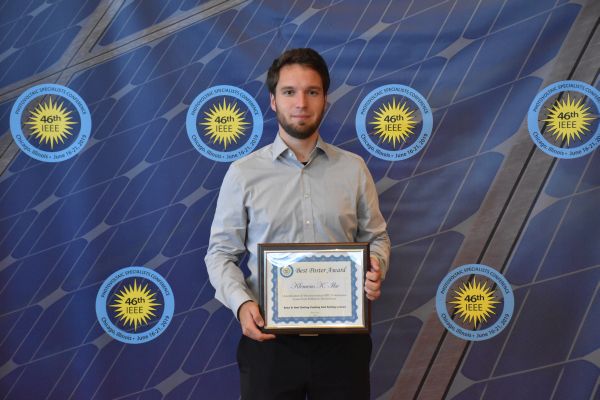Best Poster Award for Klemens Ilse
Klemens Ilse from the Fraunhofer Center for Silicon Photovoltaics CSP in Halle was awarded the Best Poster Award at the 46th IEEE Photovoltaic Specialists Conference (PVSC) in Chicago.
Over 1000 photovoltaic experts from all over the world meet once a year at the leading international conference PVSC. The best of the research contributions presented there are awarded. The researchers of the Fraunhofer CSP succeeded in convincing the jury with their work on the quantification of abrasion-induced optical losses in anti-reflective coatings.
“I am very pleased about the award and for our team,” says Klemens Ilse, currently a doctoral student at the Fraunhofer CSP. “The goal of the study was to improve the measurement methodology for determining the cleaning-related degradation of anti-reflective coatings,” says Ilse. Charlotte Pfau, Paul-Tiberiu Miclea, Stephan Krause and Christian Hagendorf were also involved in the poster. Charlotte Pfau's contribution to the creation and explanation of the calculation model used is especially worthy of mention.
Anti-reflective coatings (ARC) are critical for the performance and energy yield of photovoltaic modules. By reducing the reflection on a photovoltaic module, more light reaches the solar cells, generating more electricity. However, the light transmission of the coating can be damaged, especially if the modules are cleaned. The performance losses resulting from the wear of the coating can be measured using the method developed by the Fraunhofer CSP. The results can be used to compare and optimize the quality and resistance of different coatings, further enhancing the effectiveness of photovoltaic modules.
In their work, the researchers of the Fraunhofer CSP presented an improved method of measurement with which the losses of modules with and without coatings under signs of wear can be shown and compared. “Normally, structural glass is used for photovoltaic modules, the surfaces of which can vary and reflect differently depending on the manufacturer. To eliminate the interferences caused by scattering effects for the measurement, we have mounted a broadband absorber on the back of the test glass. This prevents unwanted measurement signals from the back of the glass,” says Klemens Ilse.
The team was able to convince the jury with this development to improve the measurement results. “Once again, the award shows that we are making important contributions to the further development of the key photovoltaic technology so that we can use it even more efficiently in the future,” says Prof. Ralph Gottschalg, Head of the Fraunhofer CSP, commenting on the success of his team.
